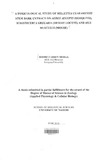| dc.contributor.author | Bosire, Carren M | |
| dc.date.accessioned | 2013-03-18T08:29:05Z | |
| dc.date.issued | 2010 | |
| dc.identifier.citation | Master of Science in Zoology (Applied Physiology & Cellular Biology) | en |
| dc.identifier.uri | http://erepository.uonbi.ac.ke:8080/xmlui/handle/123456789/14388 | |
| dc.description.abstract | Some of the many insects that proliferate in tropical environments due to conduciveness
of its weather conditions are crop pests both in the field and in storage. Others transmit
diseases and affect the health of both man and livestock. Synthetic insecticides have been
used to control them but these have shown pest resistance, they bioaccumulate and are
non biodegradable. This has led to a search for alternative insecticides and plant
insecticides are a promising source. This study investigated the potential of Millettia
usaramensis subspecies usaramensis stem bark extract as a plant insecticide and assessed
its toxicological effect on mammals. Shadow dried and powdered M usaramensis stem
bark was extracted using dichloromethanel methanol at the ratio of 1: 1 (v/v). The crude
stem bark extract was tested for larvicidal activity against the 4th instar Aedes aegypti
mosquito larvae. Probit analysis of the results showed a 48 hour activity with a median
dose of 50.82 mg/L. The crude extract administered to the locust Schistocerca gregaria
elicited insecticidal activity as indicated by LDso values of 445.65Jlg/g through injection
at 48 hours, 569.77 ug/g through topical treatment at 72 hours and 504.69 ug/g through
oral treatment at 144 hours post exposure. It also showed an anti-feedant activity of EDso
660.71 ug/ml. Pure compounds (+)-12a- epimilletosin, (+)-usararotenoid-A and deguelin
were tested in Aedes aegypti 4th instar larvae and LCso activities of 2037 mg/L, 4.27
mg/L and 2.63 mg/L respectively were observed at 48 hours post exposure .. The effect of
post-treatment temperature on the insecticidal activity of the crude extract was
investigated in S. gregaria. Increase in temperature significantly increased toxicity of the
extract by decreasing LDso from 913.65 ug/g at 25°C to 323.59 ug/g at 40°C in a 48 hour
post-treatment exposure period. No significant toxicity of the extract was observed in the
mouse Mus musculus showing that the extract is safe to non-target mammals. The results
therefore indicate that M usaramensis is a potential source of botanical insecticide(s).
Key words: Millettia usaramensis, plant insecticide, Aedes aegypti, Schistocerca
gregaria, Mus musculus, toxicological study . | en |
| dc.description.sponsorship | University of Nairobi | en |
| dc.language.iso | en | en |
| dc.publisher | University of Nairobi | en |
| dc.subject | Toxicological study | en |
| dc.subject | Millettia Usaramensis | en |
| dc.subject | Stem bark extract | en |
| dc.subject | Aedes Aegypti (mosquito) | en |
| dc.subject | Schistocerca Gregaria (desert locust) | en |
| dc.subject | mus musculus (mouse) | en |
| dc.title | A Toxicological study of Millettia Usaramensis Stem Bark extract on Aedes Aegypti (mosquito), Schistocerca Gregaria (desert locust) And Mus Musculus (Mouse) | en |
| dc.type | Thesis | en |
| local.publisher | School of Biological Sciences | en |

